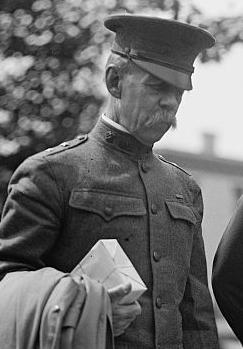Henry Granville Sharpe facts for kids
Quick facts for kids
Henry Sharpe
|
|
|---|---|

Brigadier general Henry Sharpe, 1917
|
|
| Born | April 30, 1858 Kingston, New York |
| Died | July 13, 1947 (aged 89) Providence, Rhode Island |
| Buried | |
| Allegiance | |
| Service/ |
|
| Years of service | 1880–1882, 1883–1920 |
| Rank | |
| Commands held | Commissary General of Subsistence Quartermaster General Southeastern Department |
| Battles/wars | Indian Wars Spanish–American War Philippine–American War World War I |
Henry Granville Sharpe was an important leader in the United States Army. He was born in 1858 and lived until 1947. From 1916 to 1918, he held a very important job: the Quartermaster General. This role meant he was in charge of making sure the Army had all the supplies it needed, especially during World War I.
Contents
Early Life and Education
Henry Sharpe was born in Kingston, New York, in 1858. His father, George H. Sharpe, was a brave soldier in the American Civil War. Henry followed in his father's footsteps.
He went to the United States Military Academy in West Point, New York. This is a famous school for training Army officers. Henry graduated from West Point in 1880.
Military Career Begins
After graduating, Sharpe served as a soldier on the frontier. He was stationed at Fort Laramie, Wyoming, for about a year and a half. In 1882, he left the Army for a short time.
However, he rejoined the Army in 1883. He became a "commissary of subsistence." This meant he helped manage and provide food and supplies for the soldiers. He started with the rank of Captain.
Serving in Different Places
From 1884 to 1889, Sharpe was stationed at West Point. After that, he worked as a commissary officer in many different places. These included Washington, Oregon, and St. Louis.
In 1895, he was promoted to the rank of Major. In 1897, he helped people affected by a big flood in the Mississippi River area. He bought and gave out supplies to those who needed help.
Spanish-American War Service
When the Spanish–American War was about to begin in 1898, Henry Sharpe was ready. He became the chief commissary for the First Army Corps. He traveled with his unit to Puerto Rico.
While in Puerto Rico, he was promoted again. He became a Lieutenant Colonel. He stayed there until December 1898.
Leadership in the Philippines
After a short time in Chicago, Sharpe was called to Washington, D.C. He worked as an assistant to the Commissary General of Subsistence. This job lasted until 1902.
Then, he was sent to Manila in the Philippines. He became the chief commissary for the Division of the Philippines. By this time, he was a Colonel. He was the most senior officer in the Subsistence Department.
Becoming Commissary General
Sharpe returned to Washington, D.C., in 1904. He continued to work as an assistant. On October 12, 1905, he was given a very important role. He became the Commissary General of Subsistence. This job came with the rank of Brigadier General. He was reappointed for a second term in 1909.
In 1907, General Sharpe traveled to Europe. He wanted to learn how the British, French, and German armies managed their supplies. He visited their schools for bakers and cooks. His trip helped the U.S. Army develop better equipment, like mobile kitchens.
Push for a Supply Corps
When he returned, General Sharpe suggested creating a special "supply corps" for the Army. He believed that combining different supply departments would make things more efficient. He was so passionate about this idea that he was called the "father of consolidation."
In 1912, the Army did create a new Quartermaster Corps. It combined the Quartermaster, Subsistence, and Pay Departments. Even though his friend, General James B. Aleshire, was chosen to lead it, Sharpe accepted a lower position. He worked hard to show that the new system was valuable.
World War I Challenges
In 1916, General Aleshire retired due to health issues. Henry Sharpe was then appointed to be the Quartermaster General. This happened just seven months before the United States entered World War I.
Supply Problems
The Army's supply system was not ready for such a big war. The Quartermaster Corps had to get huge amounts of supplies very quickly. But they didn't coordinate their efforts well. This led to too many supplies being shipped by train.
The train system became very crowded, and ports couldn't handle all the goods. By the winter of 1917–18, there were shortages. Soldiers in camps didn't have enough clothing or hospital equipment. Some people blamed General Sharpe for these problems.
Changes in Leadership
The supply crisis caused concern in Congress. A hearing was held to investigate the war effort. As a result, the Army's General Staff took full control of supplies. A new office was created to manage purchasing and storage.
In December 1917, a "War Council" was formed. General Sharpe was part of this council. His role was to help plan and coordinate the Army's power. While on the council, he had to let someone else handle his daily administrative duties as Quartermaster General.
In June 1918, General Sharpe was given a new assignment. He was put in command of the Southeastern Department. The next month, he was promoted to Major General. He officially stopped being the Quartermaster General.
General Sharpe retired from the Army on May 1, 1920, when he was 62 years old.
Later Life and Legacy
In his later years, General Sharpe lived in Providence, Rhode Island. He passed away there on July 13, 1947, at the age of 89. He was buried at Arlington National Cemetery, a special place for military heroes.
General Sharpe was honored for his service. In 1989, he was inducted into the Quartermaster Hall of Fame. This recognized his important contributions to the Army's supply system.
Images for kids


